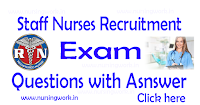Q. 1. When giving a client a diagnosis of acute pain, the nurse "using NANDA diagnostic categories" will use this
diagnosis only when the pain last no longer than which of the following lengths of time?
A. 3 days
B. 2 weeks
C. 1 month
D. 6 months
Ans: D
Q.2. The nurse is taking the client's blood pressure. The physician asks for the pulse pressure. To obtain the pulse
pressure, the nurse will have to do which of the following things?
A. Obtain a pulse-pressure machine.
B. Subtract the diastolic blood pressure from the systolic.
C. Subtract the systolic blood pressure from the diastolic.
D. Take client's apical pulse and subtract it from systolic.
Ans: B
Q.3. The skin produces and absorbs which of the following vitamins in conjunction with the ultraviolet rays of the Sun,
which activate this particular vitamin's precursor present in the skin?
A. vitamin D
B. vitamin C
C. vitamin E
D. vitamin K
Ans: A
Q.4 . The nurse receives a report at the beginning of the shift and learns that the client scores 7 on the Glasgow Coma
Scale. The nurse realizes that this client is at which of the following levels of consciousness?
A. comatose
B. moderate disability
C. severe disability
D. fully alert
Ans: A,D
Q.5 . When working in a facility that uses focus charting, the nurse will use which of the following as a focus of care?
Q.5 . When working in a facility that uses focus charting, the nurse will use which of the following as a focus of care?
A. problems identified in the initial assessment
B. maximum level of functioning
C. client identified goals and objectives
D. client concerns and strengths
Ans: D
Q.6. You would refer to the early phase of scar tissue formation as which of the following kinds of tissue?
A. Keloid
B. Cicatrix
C. granulation
D. Fibrous
Ans: C
Q.7 . When you discover an electrical fire and decide you need a fire extinguisher, you will need to find a fire
extinguisher that is rated for which class of fire?
A. Class A
B. Class B
C. Class C
D. Class E
Ans: C
Q.8. The phosphate level of a newborn is best described in which of the following ways when comparing the
newborn's phosphate level with that of an adult?
A. nearly half that of the adult
B. about one fourth that of an adult
C. nearly twice that of an adult
D. approximately the same as an adult
Ans: C
Q.9 . The lowest level of needs in Maslow's Hierarchy of Needs is which of the following?
A. safety and security needs
B. love and belonging needs
C. physiologic needs
D. self-esteem needs
Ans: C
Q.8. The phosphate level of a newborn is best described in which of the following ways when comparing the
newborn's phosphate level with that of an adult?
A. nearly half that of the adult
B. about one fourth that of an adult
C. nearly twice that of an adult
D. approximately the same as an adult
Ans: C
Q.9 . The lowest level of needs in Maslow's Hierarchy of Needs is which of the following?
A. safety and security needs
B. love and belonging needs
C. physiologic needs
D. self-esteem needs
Ans: C
Q.10 . The nursing supervisor has asked the staff to reduce the number of iatrogenic infections on the unit. Which of the
following actions on your part would contribute to reducing iatrogenic infections?
A. teaching correct hand washing to assigned clients
B. using correct procedures in starting and caring for an intravenous infusion
C. properly bagging soiled linens and disposed items used for a client in isolation
D. isolating a client who has just been diagnosed as having tuberculosis








